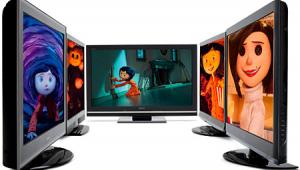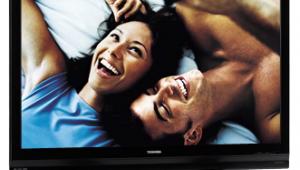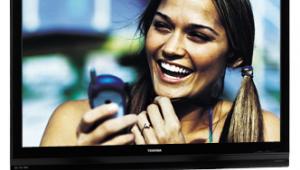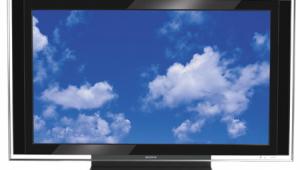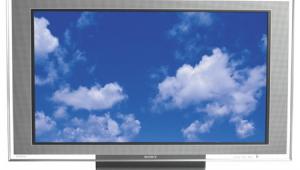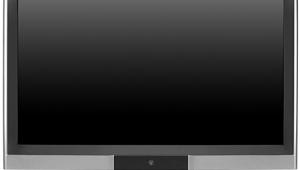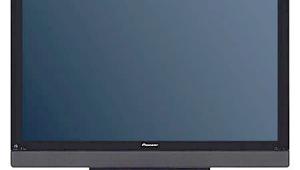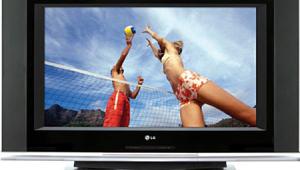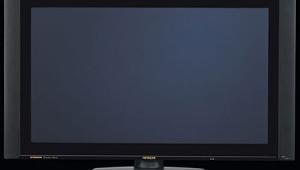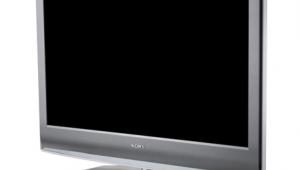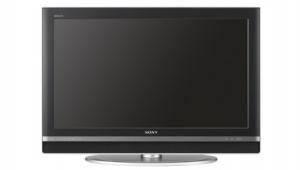5 On The Line: Flat Panel Face Off What Do You Think?
 Shane Buettner, Editor
Shane Buettner, Editor
For our February Face Off, I helped choose the sets, and we aimed high: local-dimming LCDs versus plasma for the best-of-the-best title. This time around, I had a vague idea what brands would be involved, but TJN chose and acquired the sets. I knew nothing of their feature sets or capabilities, so I was definitely brown-bagged for this tasting appointment.
February’s Face Off told me I’d know which sets were LCDs and which were plasmas as soon as I looked at them off axis. Sure enough, the Panasonic plasma quickly revealed itself as the set that made every seat the best seat in the house. But the only thing that immediately gave away the Sony’s secret identity as an LCD was the slightly smaller 40-inch screen size. I had to get farther off axis to see the image degrade than with the other LCDs tested here. The Sony’s blacks were not only astonishing, they were better than the plasma sitting next to it. Shadow detail favored the Panasonic, and in mixed scenes with strong light and dark areas, the Panasonic showed more punch in the bright areas. But it was still neck and neck. Did someone sneak a local-dimming LCD into the mix? While the plasma still had a better pic- ture off axis, the Sony’s color fidelity was far more natural and consistent, which is entirely inconsistent with my overall experience with LCDs. To top it off, turning on even a little room light killed the plasma, while the Sony still looked awesome. I’m a kook who prioritizes nighttime movie watching, but the Sony had the better blacks with the lights out, too. So my little world was really turned upside down. I’m a plasma guy. I own a plasma. I love my plasma! But this Sony was the best of the bunch.
It’s probably obvious from the word count here that the Sony and Panasonic sets were in a different class in the top two slots. At HT, we’re movie lovers, and for us blacks and contrast matter. The other sets simply lost it in darker scenes. And not torture-test scenes—we didn’t run Dark City or Master and Commander here. I’d like to say that the Vizio, the cheapest set in this Face Off, was the little LCD that could. But next to these other sets, I can’t say that the lowest-priced set yielded the best value. Nevertheless, it’s clear that the days of plasma kicking sand in LCD’s face are coming to an end. Plasma has undeniable strengths, but it doesn’t win a Face Off just by showing up anymore. The LCD is a live underdog!
 John Higgins, Contributor
John Higgins, Contributor
When we have a Face Off that mixes technologies, I always find it interesting to see how they stack up against each other. In the past, the difference between LCDs and plasmas was easily discernible, if only by the black level. But over the past couple of years, LCDs have come so far in that regard that plasmas don’t stand out as much due to black level—especially with the recent loss of Pioneer’s KUROs.
That being said, I’m not surprised that I was drawn to the one plasma display in the Face Off. The Panasonic had what looked to be the best black level and shadow detail of the group. Still, when the lights were turned on, the image looked washed out, which isn’t totally unexpected from a plasma display. If you’re thinking about it as your display, I recommend that you only use it in a dark room. I found the color on the Panasonic to be the most acceptable to my taste. Grass looked natural, but reds seemed to be slightly off. The overall detail was above average, especially on a 42-inch screen. Being a plasma, it also didn’t have motion blur tendencies that are inherent with LCDs. While the 120-hertz modes on the other displays help the problem, I’ve never been a fan of how the processing affects the image.
The Sony was a close second for me. It also had a low black level with detail in blacks, which was especially noticeable with King Kong’s facial hair in Peter Jackson’s epic. There was a crispness to the stars in Stargate: The Ark of Truth, but some light leakage from the top right corner took away from the image. It might have just been in the display we had, but I encourage any consumer to check for it. I was also thrown by the way the image changed when I moved off axis. When I moved just a seat or two away from the center, I found that the colors looked washed out and the black level seemed higher. My fellow Face Off participants didn’t have the same impression I did, but I would be reticent to use this set in a setup that didn’t have all viewers sitting as close to center as possible. It could also be a great excuse to cuddle up with someone for the night and watch some movies.
 Claire Lloyd, Executive Editor
Claire Lloyd, Executive Editor
After a full day cooped up in a dark room, watching the same demo clips over and over again, my respect for our hard-working video reviewers has taken another step up. It isn’t all fun and games, friends. These guys are patient, they watch boring material, and don’t even get me
started on the shock the sun gives you when you leave the testing studio for lunch.
That being said, it was engrossing to be part of the video reviewer’s world for the day and see the surprising way this Face Off unfolded—for me, at least. As the master of all things organizational here at Home Theater, I knew beforehand that one of the sets in the test was a plasma model. I sat smugly in the Face Off, confident that the Sony’s stunning black level and shadow detail marked it as the plasma lurking in the herd of LCDs. This was the set my eye inevitably wandered back to during the dark demo clips from The Dark Knight and Stargate: The Ark of Truth.
Naturally, I got the wind knocked out of my sails when Tom revealed the sets’ identities at the end of the day. Since I was in a roomful of video experts, I refrained from blurting out the fact that I’d misidentified the plasma. That’s our secret. The Sony’s black level and shadow detail were remarkable—that’s all there is to it.
In the color department, the Vizio was my initial favorite. However, after a couple of hours of its candy-coated goodness, I came to appreciate the Sony’s more realistic, natural palette. For example, in the chase scene from The Dark Knight, the reds, oranges, and yel- lows of explosions nicely punctuated the back- ground’s deep blues. The colors were pleasing without quite popping. This is a set I could live with at home for day-to-day watching.
Overall, the Panasonic plasma came in at a very close second on my scorecard, earning just three points less than the Sony. The Panasonic handled motion admirably and had very acceptable color and shadow detail. But its black level dropped substantially when the room lights were on, and that alone was enough to lose it my first-place vote.
This also makes two Face Offs in a row that I’ve picked the most expensive set in a blind test. Can I smell it? My fiancé thinks so. At $1,500 for a 40-inch HDTV, the Sony is still a great value for the performance you get.
 Debbie Stampfli, Contributor
Debbie Stampfli, Contributor
I am not a home theater expert by any stretch of the imagination. Although I’ve worked for Home Theater for more than a year, editing copy, reading about all the latest gear, and writing product roundups about the latest things to hit the home theater scene, I’m possibly the least qualified person to rate flat panel HDTVs. Don’t get me wrong, I’m just as impressed by a great picture as the next per-
son. And I’m not blind (although my impressions might lead some experts to believe I could be). A couple of these sets clearly surpassed the others in quality, color, and depth.
My favorite of the bunch was the Panasonic TC-P42G10 plasma. If I could’ve taken this home in the trunk of my car without anybody noticing, I would have. At Home Theater, the buzz is always about the deepest and darkest blacks. This HDTV ran circles around the others with its incredible blacks. A space scene from Stargate: The Ark of Truth made this screen pop. I could see stars in the vast blackness of space that didn’t even exist on any of the other screens. Best of all, the Panasonic didn’t lose any of its picture quality when I changed seating positions.
My second favorite was slightly more con- troversial. While all the experts in the room seemed to dislike the Vizio VL420M LCD HDTV, I really enjoyed watching it. I have a soft spot for bright, vivid colors, and this one delivered colors that were supernaturally bright. Scenes like the crowd scene in Spider- Man literally came to life on the screen. Were the colors super accurate? Not particularly. Was it a fun, bright set to watch? Absolutely. And for the price, it definitely passed my test.
I was disappointed by the difference in many of the LCD screens when I viewed them off axis. This is a known problem with LCD HDTVs, but it’s a completely different scenario when you view it firsthand. Although the blacks in the Sony KDL-40V5100 LCD HDTV were excellent, the picture faded out dramatically when it was off axis. It was a deal breaker for me.
Although I can’t say I’ve become a certified expert after this Face Off, it certainly opened my eyes to the advancements in LCDs and plasmas, as well as some of their faults. Overall, these sets show that a great quality HDTV can still be a winner regardless of budget or expertise.
 Scott Wilkinson, Contributor
Scott Wilkinson, Contributor
When the five flat panels in this Face Off were displaying bright scenes, they all looked quite good, with excellent detail and relatively minor differences that only became apparent as we carefully studied many clips. However, dark scenes were a different story. Two of the sets stood out dramatically, with deeper blacks and much better shadow detail than the other three, making this a Face Off between the Panasonic TC-P42G10 plasma and the Sony KDL-40V5100 LCD.
Going into this, I knew that there was one plasma in the bunch, which I expected to do well in the black-level department. What surprised me was how well the Sony LCD did in that department. In fact, its blacks looked even a bit deeper than the Panasonic’s. This is amazing since its backlight is a conventional CCFL, not LED with local dimming.
Even more astonishing, the Sony’s off-axis performance on dark scenes was remarkable.Yes, the apparent black level did rise a bit, but it wasn’t nearly as much as the other LCDs in the Face Off or just about any other LCD I’ve seen. On the other hand, bright scenes were totally washed out when viewed from off axis, which was very strange. Of course, the Panasonic plasma’s off-axis performance beat all the LCDs hands down.
We did most of our viewing with the lights off, but we turned them on briefly just to see what would happen to the pictures, even though all the sets had been calibrated for a dark environment. All the LCDs, especially the LG, Toshiba, and Vizio, looked a lot better under some room light. The Panasonic plasma looked much worse, with gray blacks and a seriously washed-out image. This was a clear demonstration of why LCDs sell better than plasmas in brightly lit showrooms. Unfortunately, many LCDs that look great at the retailer don’t live up to that promise once you put them in a light-controlled room.
I had a hard time choosing between the Panasonic and Sony as my top pick. I settled on the Panasonic because of its superior off-axis performance, better black-field uniformity, and rich colors, which included a slightly more crimson red than the LCDs. The Sony’s colors were just a tad undersaturated for my taste, although some of the other panelists preferred them to the Panasonic’s. And if the set was going to be watched in a room with some ambient light, I’d definitely opt for the Sony. Either way, this Face Off uncovered two gems in the 40-inch flat-panel category.
- Log in or register to post comments
